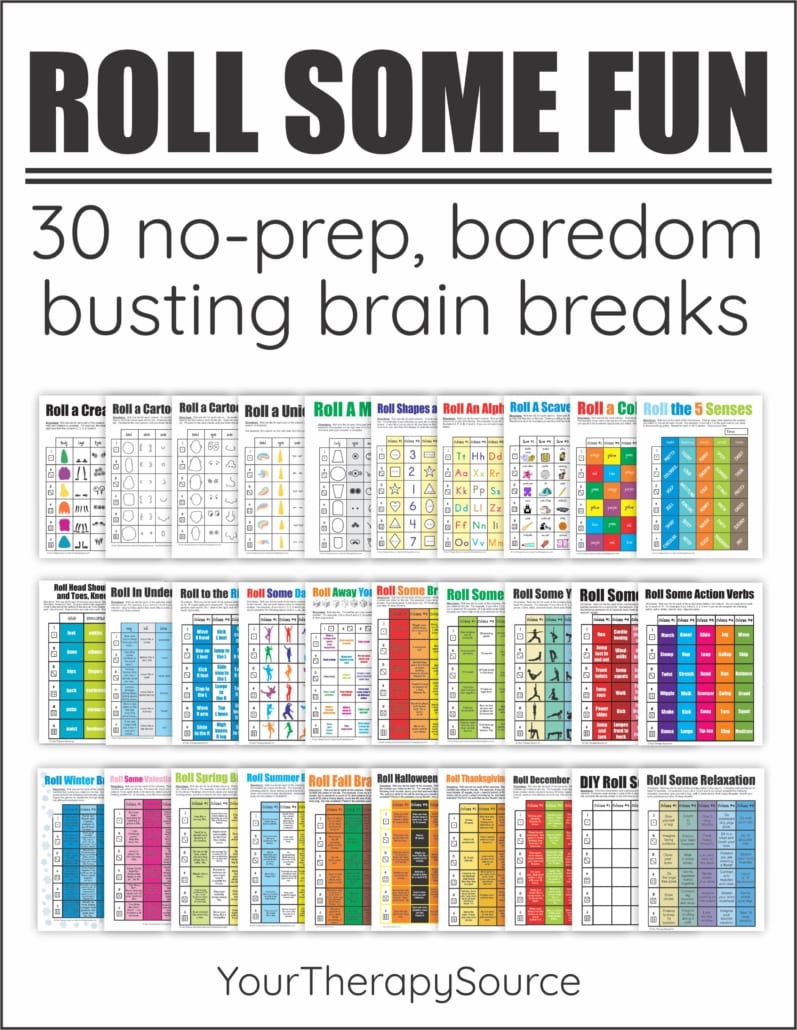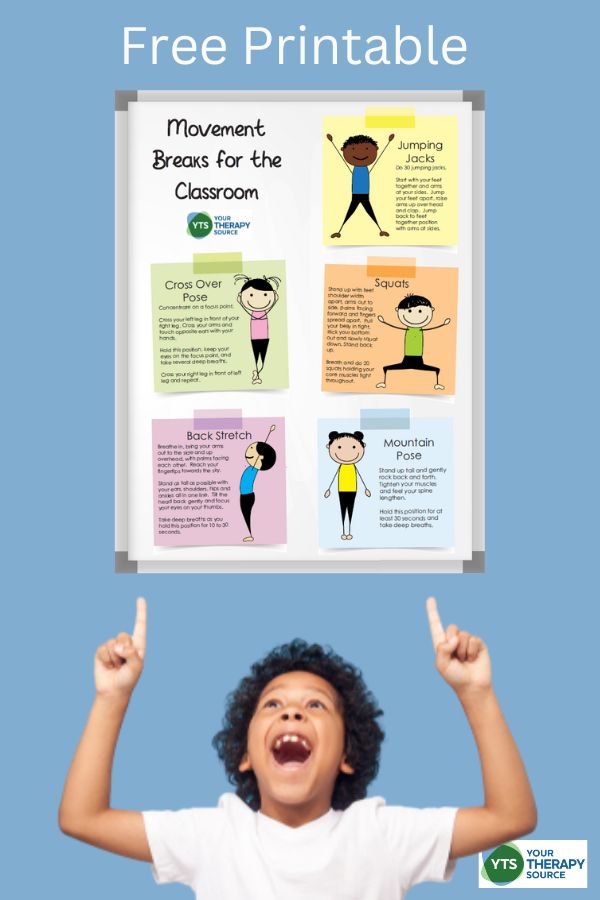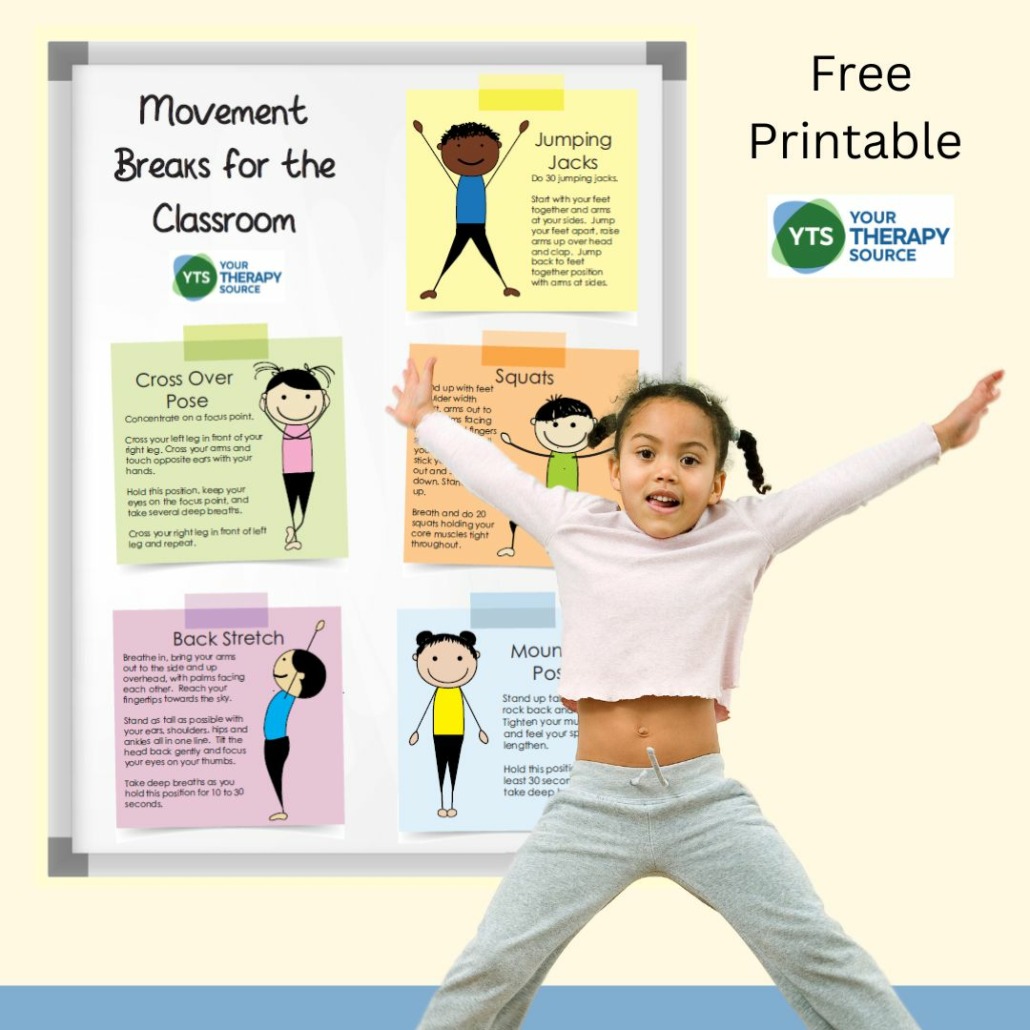Movement Breaks for the Classroom – Free and Easy Ideas

In today’s dynamic educational environment, movement breaks in the classroom have emerged as a pivotal component of effective teaching strategies. These short, structured periods of physical activity not only invigorate students but also enhance their cognitive and emotional well-being. Learn more about how these breaks can transform the classroom experience, and don’t forget to download our free printable poster featuring 5 easy-to-implement movement breaks! These 5 exercises are from the complete set of Exercise Posters for the Classroom.
What are Movement Breaks?
Movement breaks are short periods during the school day when students are encouraged to engage in physical activities. These activities, ranging from simple stretching to quick games, provide a fun way to break the monotony of class time. They are an excellent method to increase blood flow, boost energy levels, and improve students’ focus and academic performance.

Roll Some Fun Brain Breaks UPDATED
The Difference Between Movement Breaks and Brain Breaks
While often used interchangeably, movement breaks and brain breaks serve distinct purposes. Movement breaks specifically involve physical activity to stimulate blood flow and energy levels, while brain breaks might include mental or sensory activities to refresh the mind. Both are integral to a well-rounded educational brain break program.
Examples of Movement Breaks in the Classroom That Do Not Require Equipment
Movement breaks need not be complicated or require special equipment. For inspiring ideas that can be easily incorporated into your lesson plans without any additional resources, check out these fun and simple activities. These activities are particularly effective for keeping younger kids engaged and active.

Exercise Posters for Kids – Printed
Movement Breaks in the Classroom: Free Printable Poster
To help you get started, we’re offering a free printable poster featuring five diverse movement breaks suitable for any grade level. These include energizing exercises like jumping jacks, stretching activities like back stretches, strengthening moves like squats, focus-enhancing poses like the crossover pose, and calming exercises like the mountain pose.
This poster is a perfect quick brain break tool for any classroom. Find more quick brain break ideas here. You can simply show it on your smart board or print it. The freebie comes in profile or landscape view!

Integrating Movement Breaks into Daily Classroom Routine
Incorporating movement breaks into your daily routine is a great way to keep students engaged and healthy. For older students and high school settings, these breaks can be more structured and linked to the curriculum. For example, using spelling words or historical facts during a movement game. Explore different types of brain breaks and their benefits for various age groups here.
The Positive Effects of Movement Breaks on Mental and Physical Health
Regular breaks involving physical activity have shown significant positive effects on students’ mental health, attention span, and physical health. These breaks help manage stress, increase heart rate in a healthy way, and improve sensory processing. For educators looking for sensory activities suitable for sensory breaks, check out these sensory path hallway ideas.
Creative Ideas: From Dance Parties to Yoga Poses
Get creative with movement breaks! Host a dance party, practice yoga poses, or engage in whole-body movements imitating various animals. These activities are not only a good idea for physical education but also for classroom management. They offer a fun way to burn excess energy and can be tailored to suit the group size and students’ age.
Tailoring Breaks to Different Grade Levels
Movement breaks should be age-appropriate and engaging for the entire class. For younger students, simple games or animal pretend activities are ideal, while older students might enjoy more challenging physical activities or group work. Adding a special effect like music or flash cards can make these breaks more exciting.
Brain Breaks for the Classroom to Use Right Now
Incorporating movement breaks into classroom routines can be simple and effective, even within the confines of a small space. After your download the free printable poster, here are 10 versatile ideas designed to get students of all ages moving and re-energized, suitable for any classroom size:
- Desk Yoga: Utilize simple yoga stretches that can be done at or around the desk. Poses like seated twists or arm stretches are perfect for this. Yoga not only improves flexibility but also helps in calming the mind, making it ideal for students of all ages.
- Silent Disco: Have a quick, silent dance party where students can dance freely at their desk space. Use headphones if available, or simply dance to the rhythm of a silent beat. This is a fun way to get the whole class moving without creating too much noise.
- Flash Card Frenzy: Distribute flash cards with different movements written on them, such as ‘jump’, ‘twist’, or ‘reach high’. Students perform the action written on their card. This can also be educational if the cards have math problems or vocabulary words that they have to solve or define before moving.
- Chair Aerobics: Lead the class in a series of aerobic movements that can be done while sitting, such as chair marching, seated jumping jacks, or arm circles. This is a great way to increase heart rate and blood flow without needing a lot of space.
- Mirror Me: One student performs a movement and the rest of the class mirrors it. This can be a series of hand claps, facial expressions, or upper body movements. It’s a great way to encourage creativity and get everyone involved.
- Balance Challenge: Have students stand behind their chairs and perform balance exercises, such as standing on one foot or doing a tree pose. This helps with concentration and physical coordination.
- Quiet Quest: Create a mini obstacle course around the classroom where students must navigate through different stations, like walking tip-toe or balancing a book on their head. Make it a silent challenge to maintain classroom order.
- Breathing Buddies: Practice deep breathing exercises where students sit quietly and focus on their breath. They can use a small object like a stuffed animal or a bean bag on their stomachs to watch it rise and fall with each deep breath, promoting mindfulness and relaxation.
- Quick Quizzes: Need educational brain breaks? Conduct a physical response quiz where students stand for ‘true’ and sit for ‘false’, or use different hand movements for multiple-choice questions. This keeps them physically engaged while also reviewing lesson material.
- Stretch and Spell: Have students spell out new vocabulary words or key concepts using body movements. For example, ‘jump’ for each letter in a word or create a gesture that represents a concept. It’s a kinesthetic way to reinforce learning.
Each of these brain break activities can be tailored to fit different age groups and learning objectives, making them versatile tools for any teacher. By implementing these movement breaks, you help students refocus, re-energize, and engage more effectively in the learning process.

Download your FREE Printable Poster to Get Started with Movement Breaks in the Classroom
Enter your email to access the free printable.
Short breaks that include movement in the classroom are an easy way to enhance the educational experience. The activity breaks not only offer a physical health benefit but also contribute to better cognitive function, classroom management, and overall positive classroom atmosphere. Be sure to download our free printable poster to start implementing these fun brain breaks in your classroom today!
Incorporating movement breaks into your classroom routine is not just a good idea, but a necessary step towards holistic education. Start today, and witness the transformation in your students’ engagement and performance!


